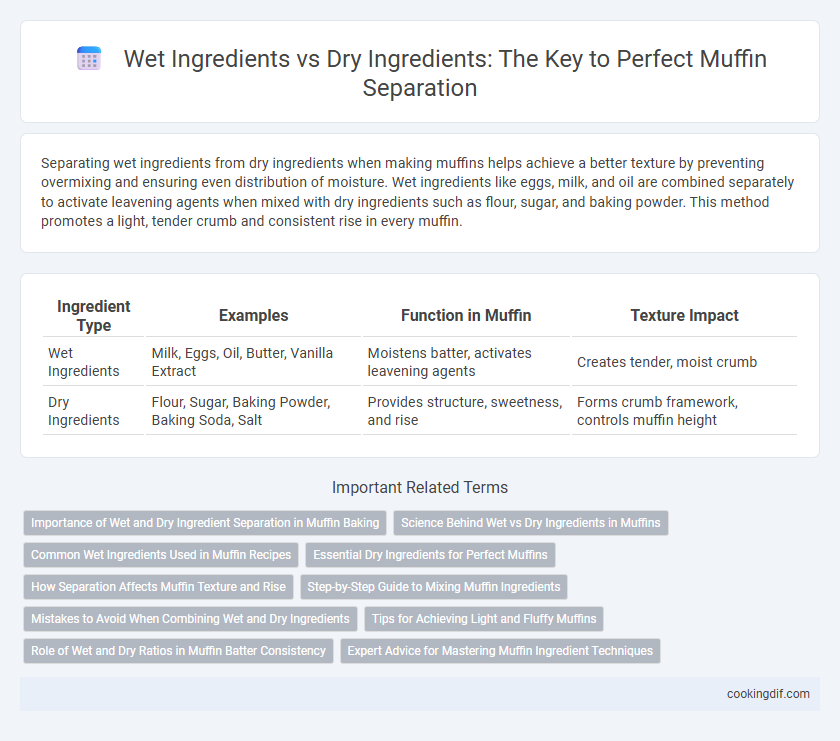Separating wet ingredients from dry ingredients when making muffins helps achieve a better texture by preventing overmixing and ensuring even distribution of moisture. Wet ingredients like eggs, milk, and oil are combined separately to activate leavening agents when mixed with dry ingredients such as flour, sugar, and baking powder. This method promotes a light, tender crumb and consistent rise in every muffin.
Table of Comparison
| Ingredient Type | Examples | Function in Muffin | Texture Impact |
|---|---|---|---|
| Wet Ingredients | Milk, Eggs, Oil, Butter, Vanilla Extract | Moistens batter, activates leavening agents | Creates tender, moist crumb |
| Dry Ingredients | Flour, Sugar, Baking Powder, Baking Soda, Salt | Provides structure, sweetness, and rise | Forms crumb framework, controls muffin height |
Importance of Wet and Dry Ingredient Separation in Muffin Baking
Maintaining the separation of wet and dry ingredients in muffin baking is crucial for achieving a tender crumb and proper texture. Overmixing combined wet and dry components can cause gluten overdevelopment, leading to dense, tough muffins instead of a light, airy consistency. This practice controls the chemical reactions between leavening agents and liquids, ensuring even rise and optimal muffin quality.
Science Behind Wet vs Dry Ingredients in Muffins
Wet ingredients in muffins, such as eggs, milk, and oil, provide moisture and help dissolve sugars and leavening agents, activating chemical reactions essential for texture and rise. Dry ingredients, including flour, sugar, and baking powder, contribute structure, flavor, and carbonation when combined with liquids, forming the muffin's crumb. Proper separation and gentle mixing prevent gluten overdevelopment, balancing hydration and aeration to produce a tender, moist muffin with an even crumb.
Common Wet Ingredients Used in Muffin Recipes
Common wet ingredients used in muffin recipes include milk, buttermilk, eggs, oil, and melted butter, which contribute to moisture and texture. Yogurt and sour cream are also frequently added to enhance tenderness and provide subtle tanginess. These wet components interact with dry ingredients like flour, sugar, and baking powder to create the ideal batter consistency for fluffy muffins.
Essential Dry Ingredients for Perfect Muffins
Essential dry ingredients for perfect muffins include all-purpose flour, baking powder, baking soda, and sugar, each playing a vital role in texture and rise. Proper measurement and sifting of flour ensure a tender crumb, while accurate baking powder and soda quantities provide optimal leavening and crumb structure. Sugar not only adds sweetness but also contributes to browning and moisture retention, balancing the muffin's overall flavor and appearance.
How Separation Affects Muffin Texture and Rise
Separating wet and dry ingredients in muffin recipes preserves the integrity of leavening agents like baking powder, promoting optimal carbon dioxide release for better rise. Proper mixing prevents gluten overdevelopment, resulting in a tender, moist crumb with desired crumb structure. This technique ensures muffins achieve a light, fluffy texture by controlling moisture distribution and chemical reactions during baking.
Step-by-Step Guide to Mixing Muffin Ingredients
Begin by thoroughly combining all wet ingredients such as eggs, milk, and melted butter in a separate bowl to ensure even moisture distribution. In another bowl, sift together dry ingredients like flour, sugar, baking powder, and salt to incorporate air and eliminate lumps. Gradually fold the wet mixture into the dry ingredients with a spatula, mixing just until combined to avoid overworking the batter and achieving a tender muffin crumb.
Mistakes to Avoid When Combining Wet and Dry Ingredients
Overmixing the batter when combining wet and dry ingredients in muffin recipes leads to tough, dense muffins due to gluten overdevelopment. Avoid adding liquid ingredients directly to the dry mix without creating a well or mixing bowl separation, as this ensures even distribution and prevents clumps. Using cold wet ingredients can hinder batter cohesion, so room temperature eggs, milk, and butter optimize the chemical reactions needed for a tender crumb.
Tips for Achieving Light and Fluffy Muffins
Separating wet and dry ingredients when making muffins helps prevent overmixing, which is key to achieving a light and fluffy texture. Combine dry ingredients like flour, sugar, baking powder, and salt in one bowl and wet ingredients such as eggs, milk, and melted butter in another before gently folding them together. Using this method minimizes gluten development and creates tender crumb structure in muffins.
Role of Wet and Dry Ratios in Muffin Batter Consistency
Wet ingredients in muffin batter, such as milk, eggs, and oil, provide moisture and influence the batter's viscosity, ensuring even mixing and proper texture development. Dry ingredients like flour, sugar, baking powder, and salt contribute structure, aeration, and flavor balance, controlling the density and crumb of the muffin. Proper ratios between wet and dry ingredients are crucial to achieving the ideal batter consistency, preventing toughness or excessive greasiness while promoting optimal rise and tenderness in the final baked muffin.
Expert Advice for Mastering Muffin Ingredient Techniques
Separating wet ingredients from dry ingredients in muffin preparation ensures even distribution of leavening agents like baking powder and baking soda, resulting in uniform rising and tender crumb texture. Experts recommend mixing wet components--such as eggs, milk, and oil--individually before combining them with dry ingredients like flour, sugar, and salt to prevent overmixing, which can cause tunnels and toughness. Mastery of this technique optimizes muffin moisture and softness while preserving desired crumb structure.
Wet ingredients vs Dry ingredients for muffin separation Infographic

 cookingdif.com
cookingdif.com